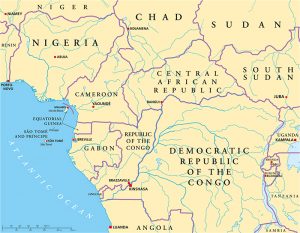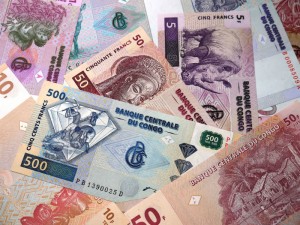The Congo has a magical allure for adventurous travellers. Its very name conjures up images of dense rainforests that stretch beyond the limits of human vision, gorillas and okapis, pygmies and sluggish rivers, dreadful roads and serious adventure. Quite simply there’s nowhere else on Earth quite like the Congo.
But before you dive into its often muddy heart let’s get a few geography related issues out of the way. When people talk of the Congo they’re generally referring to either the rainforest itself, in which case they’re talking about an area that spreads across some half a dozen countries and touches a number of others. Or, they’re talking solely about a country called the Congo, and in that instance there’s a choice of two countries: The Democratic Republic of Congo (often shortened to the DRC) and the neighbouring Republic of Congo (sometimes called Congo-Brazzaville). Despite a slowly improving situation, the DRC is one of the most challenging and formidable countries in the world to travel through. It’s been wracked by war, corruption and mismanagement for decades and much of the vast interior is as little known to the outside world as it was Stanley hacked his way through at the close of the 19th Century.
The Republic of Congo is the little brother of the DRC. It too has gone through more than its fair share of violent upheaval and political greed, but now its wild days of youth seem to be behind it and, with vastly improved infrastructure, some political stability and an increasing push for international tourists, the Congo is finally revealing its natural wonders to the wider world.
This is our guide to making the most of the Republic of Congo.
Brazzaville
Staring across the Congo River (which here can seem as wide as an ocean) towards the bright lights of massive Kinshasa (the capital of the DRC), Brazzaville feels in comparison like a sleepy backwater. And frankly we quite like it like that. The city centre is safe and friendly (at least by day) and has wide streets and lots of table cafes. Actual tourist sights are a little lacking, but the Marché Total is a big market area selling everything you’d expect — and quite a lot you wouldn’t (bushmeat, magical charms and so on). The city doesn’t make much of its riverside setting and it can be hard to get a decent view of this most mythical of rivers, but head down to Pont Djoué and you can sit in a café and take in the infamous rapids that prevent any kind of boat travel from Brazzaville (and Kinshasa) to the coast.
Pointe-Noire
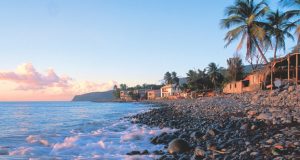
Pointe-Noire (Courtesy of SSAFARA)
The second city of Congo, Pointe-Noire is a small city with ocean breezes, palm trees and some reasonably pleasant beaches. It’s also a major port and an oil city. Not many people would fly halfway around the world simply to come to the beach here, but if you’re in Congo and fancy washing the jungle mud off, then the warm-water beaches and somewhat down-at-heel resorts of Pointe-Noire will do nicely.
Parc National Conkouati-Douli
Very different from any other Congolese national park, Conkouati-Douli consists of empty Atlantic beaches where turtles haul themselves up onto the sand to lay eggs, open savannah plains where buffalo chew their cud, and along the rivers and on the mountain slopes, patches of forest where gorillas flit through the shadows. There’s also a chimpanzee rehabilitation centre where you can get up close to semi-wild chimps.
Parc National d’Odzala
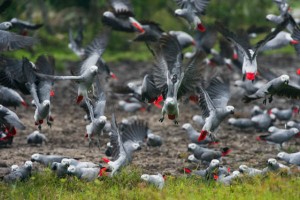
Odzala NationalPark (Courtesy african-parks.org)
Odzala is the Congo at its most impressive – and most tourist friendly. The dense lowland rainforest here is home to hundreds, maybe thousands, of western lowland gorillas including some that have been habituated to human visitors. There are also lots of forest elephants and buffalo, both of which are frequently seen, and far more shy, groups of chimpanzees. Odzala is home to the first and only luxury safari lodge in the country, Odzala Discovery Camps. As well as gorilla and wildlife watching, the camp offers forest walks with the Baka (pygmies) people and boat rides. The lodge transports clients part way by plane, then drives them the rest of the way in a private bus. This is probably the easiest way to get to Odzala.
Parc National Nouabalé-Ndoki

Nouabalé-Ndoki (Courtesy of Congo Travel and Tours)
This is the Congo of the imagination: A vast, trackless and only vaguely explored slab of steamy jungle bustling with life big and small. Unusually for a forest park most, of the wildlife here is easily seen thanks to a number of large natural forest clearings known as bais, where seemingly every member of the forest community gathers to feast on the salts in the soil or the nutritious swamp plants. Park authorities have constructed a number of raised viewing platforms from which you can sit back with a drink and watch the animals come to you. At one point during our last visit we saw four or five elephants, a number of buffalo, a dozen or more western lowland gorillas, some bushbuck and forest pigs and even a family of chimpanzees all in the bai at exactly the same time. There are also a couple of families of very well-habituated gorillas. Yes, this is a special place. The tourist facilities of the park are run by the World Conservation Society and all bookings should be made through them. Sadly though, they’re not all that organised.
Lac Télé
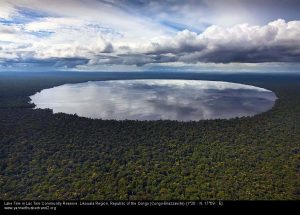
Lac Télé (Courtesy of yannarthusbertrand2.org)
If Odzala and Nouabalé-Ndoki come across as a bit tame for you then Lac Télé in the extreme north might be for you, but be warned that the area around this perfectly circular lake is some of the wildest and least-known territory on the planet. It’s rumoured that the swamp forests here are home to thousands of lowland gorillas, elephants and all the other forest megafauna. The Baka people who live here are said to be barely impacted by the outside world. Oh, and then there’s the Mokèlé-Mbèmbé – a type of aquatic dinosaur rumoured to live in the endless swamps here… Needless to say Lac Télé is not a place to approach lightly. You’ll need a LOT of time and money to get there and be prepared to walk, wade, swim and live off the bush for weeks on end to even get there.
Getting There
Boats travel several times a day to Brazzaville from Kinshasa. You can also cross overland from Gabon, Central African Republic and Cameroon. Most of these border crossings are very adventurous, to say the least. If you want to arrive by air, Brazzaviille and Pointe-Noire are increasingly well connected to the rest of Africa and Europe, with direct flights from Paris offered by Air France.
Practical Details
Visas: One-month tourist visas are easily available from Congolese embassies for most travelers. Other nationalities can get a two-week visa on arrival. Check with your local Congolese embassy or consulate.
Costs: Although you could travel around Congo cheaply, if you want to visit the national parks then prepare to part with some serious money. Chartering the boats, jeeps and planes you need to reach most of these places quickly adds up.
Security: Nowadays most of Congo is perfectly safe. Avoid walking around Brazzaville and Pointe-Noire at night, and get a guide or experienced tour outfitter if you are headed to a remote area like Lac Télé.
Related content on AFKTravel.com:
10 Things To See And Do In The Democratic Republic Of The Congo
Mysterious Waters: 10 Things You Didn’t Know About The Congo River

